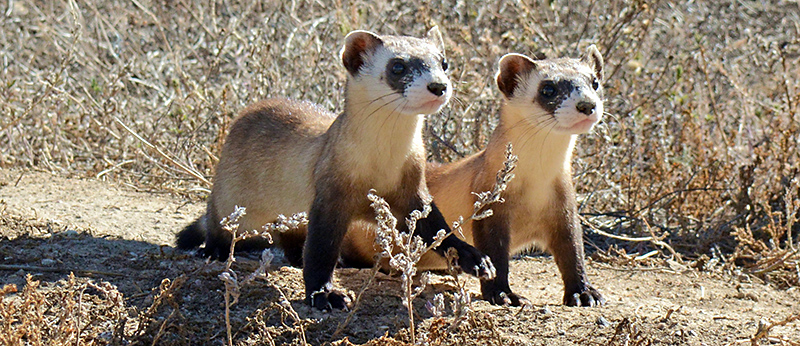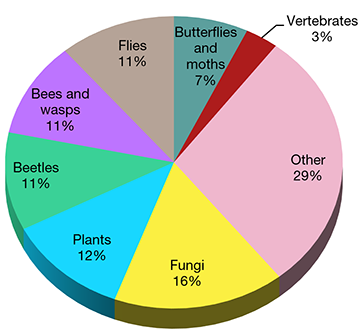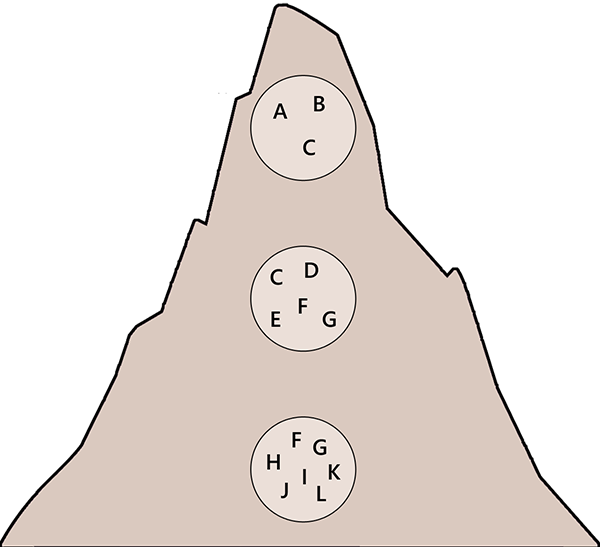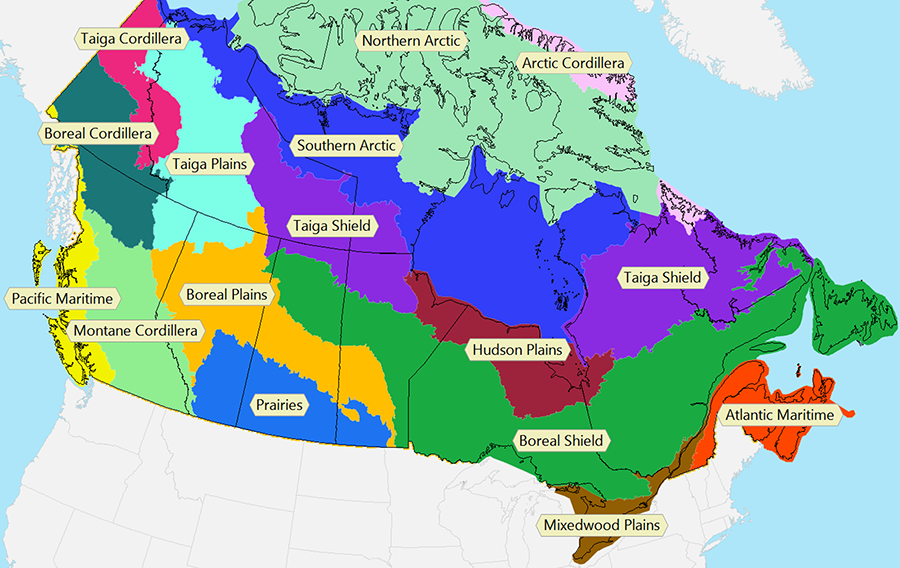An Introduction to Conservation

Defining Biodiversity
We will begin our exploration of conservation with a high-level overview, starting with the components of biodiversity—the targets of our conservation efforts. We will then sketch out, in broad strokes, the biocentric and social models of conservation practice, establishing a foundation that subsequent chapters will build on.
Biodiversity refers to the variety of life in all its forms and at all levels of organization. Three levels of organization are usually distinguished: species, genes, and ecosystems. We will examine each of these levels in turn, emphasizing foundational concepts. In later chapters, we will revisit these concepts from the perspective of applied conservation.
Species Diversity
A species is defined as a group of organisms capable of interbreeding under natural conditions. However, this definition is difficult to apply in practice because it requires information about reproduction patterns that is generally unavailable. Therefore, taxonomists commonly differentiate species on the basis of physical and functional characteristics and, more recently, DNA barcodes (Coissac et al. 2016).
Researchers estimate that the total number of species on earth is somewhere between 2–8 million, not including bacteria or viruses (Costello et al. 2013). Species diversity is greatest in tropical regions and declines as one moves poleward (Willig et al. 2003). For example, the Amazonian lowlands contain an estimated 16,000 tree species, whereas there are less than 200 native tree species across all of Canada (Ter Steege et al. 2013).

In total, Canada has approximately 80,000 known species (excluding bacteria and viruses), and there are many yet to be identified (CESCC 2022). Vertebrates and vascular plants have been well studied but the vast majority of species are simpler life forms (Fig. 1.1), and only a fraction of these species have been catalogued. The more we look, the more we find.
A common measure of species diversity is species richness, which is the number of species in a given area. There are also more refined measures of diversity that take spatial scale into account (Jost 2007). These include alpha diversity, which is the number of species in a specific location; beta diversity, which describes how species composition changes across space; and gamma diversity, which describes the overall number of species across a broad region (Fig. 1.2). In real landscapes, these measures are often correlated.
 |
Fig. 1.2. A conceptual illustration of diversity patterns on a mountainside. The circles represent study sites, and the letters represent the individual species present. In this example, alpha diversity—the number of species within each site—decreases with altitude. There is little overlap in species composition among sites; therefore, beta diversity is high. Gamma diversity is the total number of species on the mountain (i.e., 12). |
Of course, it is not only the number of species that matters but the diversity in traits and life strategies within the community. Important aspects of this diversity include:
- Functional role (e.g., predator, herbivore, decomposer, etc.)
- Habitat use (e.g., habitat specialist or generalist)
- Life history strategy (e.g., short lifespan, many offspring at a time, and minimal parental care vs. long lifespan, few offspring at a time, and high parental investment)
- Behavioural traits (e.g., herding vs. solitary; migratory vs. stationary)
Another attribute of relevance to conservation is whether a species is common or rare. There are three forms of rarity to be considered. First, some species are rare because they normally exist at very low population densities (e.g., the wolverine). Second, some species are associated with uncommon habitat types (e.g., patches of recently burned forest). Third, some species are rare because they have a very localized range (e.g., the Vancouver Island marmot).
The term endemic is often used to describe species with a restricted range. For example, we would say that the Vancouver Island marmot is endemic to Vancouver Island. While this usage of the term is correct, it should be noted that range size is not actually part of the definition. Endemic simply means that a species is found only in one geographic location. So, for example, the muskrat is endemic to North America.
Genetic Diversity
Genetic diversity arises from spontaneous DNA mutations that are passed down from parent to offspring. These mutations are rare, but they accumulate within a species over evolutionary time. The full complement of genetic variants that exists within a species is referred to as its gene pool. The variant forms of individual genes are referred to as alleles.
Through natural selection, beneficial mutations tend to become widely distributed among individuals, whereas deleterious mutations tend to be weeded out. However, because environmental conditions fluctuate over time, natural selection is faced with a moving target. In the face of changing conditions, no single set of genetic variants will be universally optimum (Reed et al. 2011). Instead, species are best served by having a diverse gene pool containing genetic variants that are adaptive under different conditions (Kremer et al. 2012). This allows species to adjust to environmental changes much faster than if they had to wait for new adaptive mutations to arise.
Another aspect of genetic diversity is spatial structure. Many species are divided into distinct populations—groups of individuals that live in a particular geographical area and normally breed with one another. Populations that reside in separate regions may experience different environmental conditions and different selective pressures (Fraser et al. 2011). This can result in localized genetic differences, especially if the rate of gene flow (i.e., reproductive mixing) among populations is low because of physical barriers or distance (Savolainen et al. 2007). Given enough time and isolation, sufficient differences can accumulate within populations to result in the formation of new species.
In Chapter 6, we will examine genetic diversity as it relates to extinction dynamics and the designation of species at risk. We will also discuss methods for maintaining genetic diversity. In Chapter 9, we will revisit genetics in the context of adapting to global warming.
Ecosystem Diversity
An ecosystem is a group of interacting organisms and the physical environment they inhabit. The living members of an ecosystem are referred to as a community. Unlike species and genes, ecosystems are not discrete entities. Although some distinct boundaries do exist, such as between a lakeshore and forest, most ecosystems change gradually across space in response to environmental gradients.
For example, hiking up a mountain trail, we find that the mix of tree species gradually changes with altitude, and at the highest elevations, trees become stunted and eventually give way to open meadows. These changes are driven by a climatic gradient: higher elevations are associated with lower mean temperature, higher moisture levels, and shorter growing season. Because the climatic changes are gradual, so too are the ecological transitions.
The factors that generate ecological patterns are scale-dependent (Willis and Whittaker 2002). At broad scales (like provinces), regional climate and large physical features are most important. At intermediate scales, soils, topography, and large-scale disturbance events (e.g., fire and insect outbreaks) are the major drivers. At the local scale, biotic interactions, small-scale disturbances, and microclimate have an overriding effect.
The ecosystem boundaries we define are largely artificial constructs developed for specific management purposes. For example, when the focus is on aquatic biodiversity, ecosystems may be delineated using watershed boundaries. The classification system most relevant for terrestrial conservation planning is the National Ecological Framework for Canada (Fig. 1.3), developed by the federal and provincial governments (Marshall et al. 1999). This classification delineates ecosystems on the basis of climate, topography, geology, soils, hydrology, vegetation, and fauna. Ecosystems are defined hierarchically, with three main divisions: ecozones (n=15), ecoregions (n=194) and ecodistricts (n=1,021). Some provinces have developed classifications that extend this hierarchy to even finer scales.

Individual ecosystems are described in terms of three main attributes: composition, structure, and function. Composition refers to the individual elements that comprise the system, especially the species that are normally present. Structure refers to how these elements are arranged in three-dimensional space. For example, consider the horizontal and vertical structure of a forest. Structure also includes the relative abundance of species. Some ecosystems are dominated by just a few species, whereas others have a more even distribution of species. Function refers to the various processes that occur within the system, both biotic (e.g., competition) and abiotic (e.g., nutrient cycling).
A process of particular relevance to conservation is disturbance. Natural disturbances (fires, insect outbreaks, storms, droughts, etc.) are a normal and necessary part of ecological systems. They reset succession, resulting in much greater ecological complexity than would otherwise exist. In contrast, anthropogenic disturbances (i.e., of human origin), especially those with no natural analog, can disrupt ecosystems and cause species to decline (see Chapter 5).

